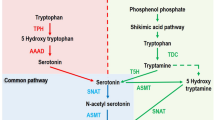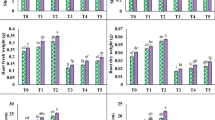Abstract
The effects of salicylic acid (SA) and jasmonic acid (JA) on plant defense responses were studied with aseptic potato (Solanum tuberosum L.) plantlets infected with Phytophthora infestans (Mont.) de Bary. Plant treatment with 10−6 M SA or 10−7 M JA induced plant resistance; the mixture of these acids was most efficient. After treatment with these compounds, phenolic compounds were accumulated and peroxidase was activated in the sites of pathogen localization, and this might be the reason of resistance enhancement. In addition, more H2O2 was accumulated in infected plants treated with JA or its mixture with SA but not in plants treated with SA alone. It might occur because of observed inhibition of catalase and activation of isoperoxidase with the isoelectric point (pI) of ∼9.3, which manifests an affinity for the pathogen cell wall. The data obtained allow us to recommend the application of these compounds for potato plant protection against late blight.
Similar content being viewed by others
Abbreviations
- DAB:
-
3,3-diaminobenzidine
- HR:
-
hypersensitive response
- JA:
-
jasmonic acid
- PB:
-
Na-phosphate buffer
- SA:
-
salicylic acid
- SIR:
-
systemic induced resistance
References
Cohen, Y., Gisi, U., and Niderman, T., Local and Systemic Protection against Phytophthora infestants Induced in Potato and Tomato Plants by Jasmonic Acid and Jasmonic Methyl Ester, Phytopathology, 1993, vol. 83, pp. 1054–1062.
Hukkanen, A.T., Kokko, H.I., Buchala, A.J., McDougall, G.J., Stewart, D., Karenlampi, S.O., and Karjalainen, R.O., Benzothiadiazole Induces the Accumulation of Phenolics and Improves Resistance to Powdery Mildew in Strawberries, J. Agric. Food Chem., 2007, vol. 55, pp. 1862–1870.
Vasyukova, N.I., Chalenko, G.I., Gerasimova, N.G., Valueva, T.A., and Ozeretskovskaya, O.L., Activation of Elicitor Defensive Properties by Systemic Signal Molecules during the Interaction between Potato and the Late Blight Agent. Applied Biochemistry and Microbiology, 2008, vol. 44, pp. 213–217.
Plotnikova, L.Ya., Effect of Benzothiadiazole, an Inducer of Systemic Acquired Resistance, on the Pathogenesis of Wheat Brown Rust, Russ. J. Plant Physiol., 2009, vol. 56, pp. 517–526.
Panina, Ya.S., Gerasimova, N.G., Chalenko, G.I., Vasyukova, N.I., and Ozeretskovskaya, O.L., Salicylic Acid and Phenylalanine Ammonia-Lyase in Potato Plants Infected with the Causal Agent of Late Blight, Russ. J. Plant Physiol., 2005, vol. 52, pp. 511–515.
Shetty, N.P., Jorgensen, H.J.L., Jensen, J.D., Collinge, D.B., and Shetty, H.S., Roles of Reactive Oxygen Species in Interaction between Plants and Pathogen, Eur. J. Plant Pathol., 2008, vol. 121, pp. 267–280.
Bolwell, G.P. and Daudi, A., Reactive Oxygen Species in Plant-Pathogen Interactions, Signaling and Communication in Plants. Book 2. Reactive Oxygen Species in Plant Signaling, Baluška, F. and Vivanco, J., Eds., Berlin: Springer-Verlag, 2009, pp. 113–133.
Chumakov, A.E. and Zakharova, T.I., Vredonosnost’ boleznei sel’skokhozyaistvennykh kul’tur (Harmfulness of Crop Diseases), Moscow: Agropromizdat, 1990
Mellersh, D.G., Foulds, I.V., Higgins, V.J., and Heath, M.C., H2O2 Plays Different Roles in Determining Penetration Failure in Three Diverse Plant-Fungal Interactions, Plant J., 2002, vol. 29, pp. 257–268.
Ermakov, A.I., Arasimovich, V.V., and Yarash, N.P., Metody biokhimicheskogo issledovaniya rastenii (Methods for Plant Biochemical Investigations), Leningrad: Agropromizdat, Leningradskoe otd., 1987.
Feofilova, E.P., Fungal Chitin: Distribution, Biosynthesis, Physical and Chemical Features, and Perspectives in Its Investigations, Khitin i khitozan: poluchenie, svoistva i primenenie (Chitin and Chitosan: Production, Features, and Use), Skryabin, K.G., Vikhoreva, G.A., and Varlamov, V.P., Eds., Moscow: Nauka, 2002, pp. 100–112.
Bindschedler, L.V., Minibayeva, F., Gardner, S.L., Gerrish, C., Davies, D.R., and Bolwell, G.P., Early Signaling Events in the Apoplastic Oxidative Burst in Suspension Cultured French Bean Cells Involve CAMP and Ca2+, New Phytol., 2001, vol. 151, pp. 185–194.
Hardham, A.R. and Shan, W., Cellular and Molecular Biology of Phytophthora-Plant Interaction, The Mykota: 5. Plant Relationships, Deising, H., Ed., Berlin: Springer-Verlag, 2009, pp. 3–27.
Maksimov, I.V., Cherepanova, E.A., and Khairullin, R.M., “Chitin-Specific” Peroxidases in Plants, Biochemistry (Moscow), 2003, vol. 68, pp. 111–115.
Koorneef, A., Verhage, A., Leon-Reyes, A., Snetselaar, R., van Loon, L.C., and Pieterse, C.M.J., Towards a Reporter System to Identify Regulators of Cross-Talk between Salicilate and Jasmonate Signaling Pathways in Arabidopsis, Plant Signal. Behav., 2008, vol. 3, pp. 543–546.
Mur, L.A.J., Kenton, P., Atzorn, R., Miersch, O., and Wasternack, C., The Outcomes of Concentration-Specific Interactions between Salicylate and Jasmonate Signaling Include Synergy, Antagonism and Oxidative Stress Leading to Cell Death, Plant Physiol., 2006, vol. 140, pp. 249–262.
Pena-Cortes, H., Albrecht, T., Prat, S., Weiler, E.W., and Willmitzer, L., Aspirin Prevents Wound-Induced Gene Expression in Tomato Leaves by Blocking Jasmonic Acid Biosynthesis, Planta, 1993, vol. 191, pp. 123–128.
Ayoung, L., Kyoungwon, C., Sungkuk, J., Rakwal, R., Iwahashi, H., Ganesh, K.F., Shim, J., and Oksoo, H., Inverse Correlation between Jasmonic Acid and Salicylic Acid during Early Wound Response in Rice, Biochem. Biophys. Res. Commun., 2004, vol. 318, pp. 734–738.
Takahashi, H., Kanayama, Y., Zheng, M.S., Kusano, T., Hase, S., Ikegami, M., and Shah, J., Antagonistic Interactions between the SA and JA Signaling Pathways in Arabidopsis Modulate Expression of Defense Genes and Gene-for-Gene Resistance to Cucumber Mosaic Virus, Plant Cell Physiol., 2004, vol. 45, pp. 803–809.
Repka, V., Fisherova, I., and Silharova, K., Methyl Jasmonate Is a Potent Elicitor of Multiple Defense Responses in Grapevine Leaves and Cell-Suspension Cultures, Biol. Plant., 2004, vol. 48, pp. 273–283.
Hung, K.T., Hsu, Y.T., and Kao, C.H., Hydrogen Peroxide Is Involved in Methyl Jasmonate-Induced Senescence of Rice Leaves, Physiol. Plant., 2006, vol. 127, pp. 293–303.
Liu, Y., Pan, Q.-H., Yang, H.-R., Liu, Y.-Y., and Huang, W.-D., Relationship between H2O2 and Jasmonic Acid in Pea Leaf Wounding Response, Russ. J. Plant Physiol., 2008, vol. 55, pp. 765–775.
Haggag, W.M., and Abd, El Kareem, F., Methyl Jasmonate Stimulates Polyamines Biosynthesis and Resistance against Leaf Rust in Wheat Plants, Arch. Phytopathol. Plant Protect., 2009, vol. 42, pp. 16–31.
Kawano, T. and Furuichi, T., Salicylic Acid as a Defense-Related Plant Hormone: Roles of Oxidative and Calcium Signaling Paths in Salicylic Acid Biology, Salicylic Acid: A Plant Hormone, Berlin: Springer-Verlag, 2007, pp. 277–322.
Wu, G.S., Short, B.J., Lawrence, E.B., Levine, E.B., Fitzsimmons, K.C., and Shah, D.M., Disease Resistance Conferred by Expression of a Gene Encoding H2O2-Generating Glucose Oxidase in Transgenic Potato Plants, Plant Cell, 1995, vol. 7, pp. 1357–1368.
Author information
Authors and Affiliations
Corresponding author
Additional information
Original Russian Text © I.V. Maximov, A.V. Sorokan’, E.A. Chereoanova, O.B. Surina, N.B. Troshina, L.G. Yarullina, 2011, published in Fiziologiya Rastenii, 2011, Vol. 58, No. 2, pp. 243–251.
Rights and permissions
About this article
Cite this article
Maksimov, I.V., Sorokan’, A.V., Chereoanova, E.A. et al. Effects of salicylic and jasmonic acids on the components of pro/antioxidant system in potato plants infected with late blight. Russ J Plant Physiol 58, 299–306 (2011). https://doi.org/10.1134/S1021443711010109
Received:
Published:
Issue Date:
DOI: https://doi.org/10.1134/S1021443711010109




